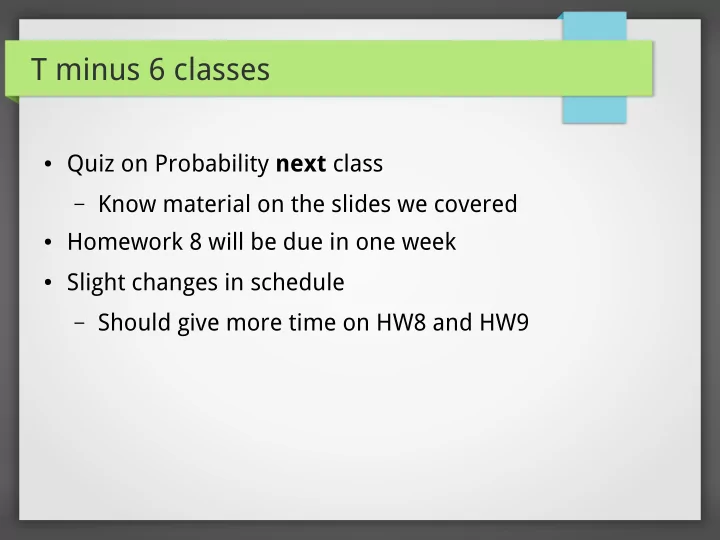

T minus 6 classes ● Quiz on Probability next class – Know material on the slides we covered ● Homework 8 will be due in one week ● Slight changes in schedule – Should give more time on HW8 and HW9
CMSC 203: Lecture 21 More Probability
Bayes' Theorem ● Suppose that E and F are events from a sample space S such that
Bayes' Theorem Terms ● H : Hypothesis ● E : Evidence ● p(H) : “Prior” probability of H ● p(H|E) : “Posterior” probability ● p(E|H) : “Likelihood” ● p(E) : Normalizing constant
Bayes' Theorem Application ● There is a rare disease that 1 in 100,000 people has. There is a test that is correct 99.0% of the time when the person has the disease, and 99.5% correct when testing a person who does not have the disease. Can we find: – probability a person who tests positive has disease? – probability a person who tests negative doesn't? Disease :( No disease! :) Positive Test CORRECT False positive Negative Test False negative CORRECT
Random Variables ● A function from sample space of an experiment to the set of real numbers – A random variable assigns a real number to each possible outcome – Not actually a variable; not actually random ● Your book hates this, too
Example of Random Variable ● Let be the random variable that equals the number of heads that appear when t is the outcome
Distribution of Random Variable ● The distribution of a random variable X on sample space S is the set of pairs for all where is the probability X takes the value r ● Example : Taking 3 coin flips from the previous example ● Therefore, the distribution of is the set of pairs:
Examples of Random Variables ● Sum of numbers when dice is rolled ● Amount of rain (or snow) that falls on a particular day ● How many goats you can win in Monty Hall problem ● All probability distributions
Expected Value ● Expected value : The average value of a random variable when an experiment is performed many times – Number of heads expected to show up? – Expected number of comparisons to find element in a list using a linear search? – Expected value of playing the lottery / poker / drilling giant holes into the Earth to find oil ● Also called the expectation or mean of a random variable
Expected Value Formula ● Expected value of random variable X on sample space S ● Example: Let X be the number that comes up when a die is rolled. What is the expected value of X ? ● The final exam of a discrete mathematics course consists of 50 true/false questions, each worth two points , and 25 multiple- choice questions, each worth 4 points . The probability that a student answers a T/F question correctly is .9 and the chance they answer a multiple choice question correctly is .8 . What is their expected score?
St. Petersburg Paradox ● There's a new gambling game at the casino: – Single player game, consisting of 1 fair coin – The pot starts at $1, and the coin is flipped: ● If heads, the pot is doubled ● If tails, the game ends and you win the pot – tl;dr - you win dollars if heads comes on flip ● What is the expected value of this game? How much would you pay to play this game?
CMSC 203: Lecture 21 Relations
What is Relations? ● Relation : A strcture that represents the relationships between elements of sets ● Subset of the Cartesian product of the sets ● Examples: – Pairs of cities linked by airline flights? – Phases of a project in a viable order? – Storing information in a database?
Expressing Relations ● Most direct way to express relationship between elements in two sets is ordered pairs ● Sets of ordered pairs are binary relations – Binary relation from A to B is a subset of A x B – ● Example : Let A be the set of students at UMBC and B be the set of courses. Let R be the relation that consist of pairs ( a, b ) where a is a student enrolled in course b .
Functions as Relations ● Recall function f from A to B maps elements exactly one element in B to every element in A ● Graph of f is a set of ordered pairs ( a , b ) where b = f(a) ● Graph of f is a subset of A x B, so it is a relation ● Relations are a generalizations of graphs of functions
Relations on a Set ● A relation on a set A is a relation from A to A ● Example s: – A is the set {1, 2, 3, 4}. Which ordered pairs are in the relation R = {(a, b) | a divides b}? – Which of these relations contain the pair (1, 2): ● ● ●
Properties of Relations ● Reflexive – ● Symmetric – ● Antisymmetric – ● Transitive –
Combining Relations ● Two relations from A to B can be combined in any way two sets can be combined – Due to relations being subsets of A x B ● We can perform operations such as – – – – –
Recommend
More recommend